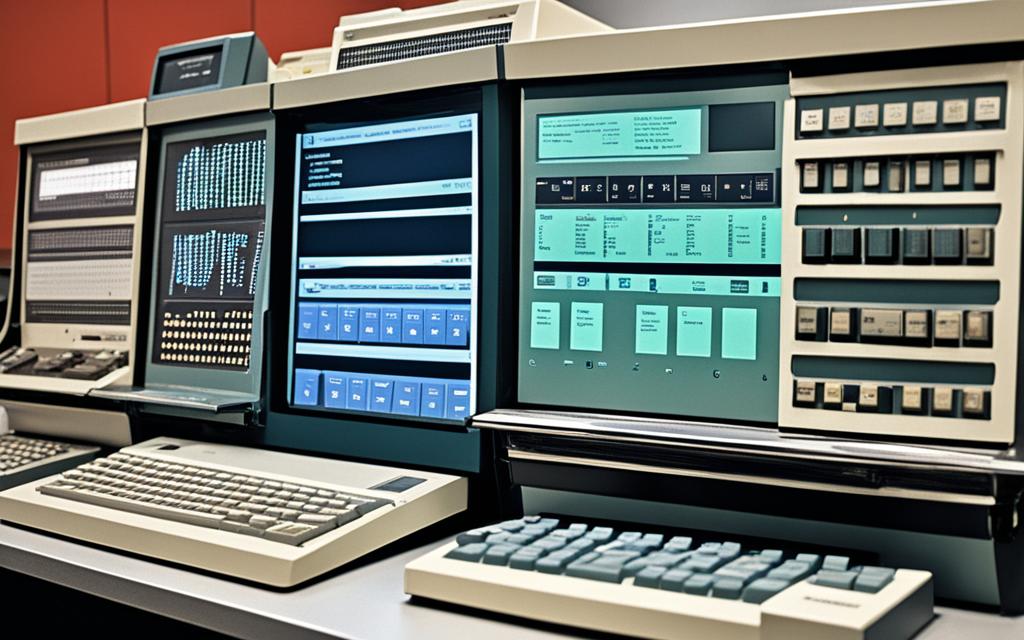Table of Contents
Human-Computer Interaction (HCI) has seen huge changes since it started. It’s now an important area that combines computer science, cognitive psychology, and design. The development of HCI shows us a rich history of how humans interact with. Usability principles have grown more complex. This has changed how we make software and hardware. We will look at the main events that have shaped HCI. These events have brought new ways to improve how we use technology.
The 1970s marked the start of HCI with the rise of personal computers. We see how the graphical user interface (GUI) made computers easier for everyone. This replaced the older, harder-to-use command-line interfaces. Then, in the following years, cognitive psychology helped us understand how people think and what they need. This knowledge has formed the digital world we all use today.
Now, we are seeing new trends like mobiles, artificial intelligence, and virtual reality. These innovations are making HCI even more exciting. They show us a world where technology gets closer to our daily lives. Each step brings something new to look forward to in HCI.
Key Takeaways
- HCI has evolved from command-line interfaces to visually rich graphical user interfaces.
- The integration of cognitive psychology in the 1990s enhanced the understanding of user interaction.
- Emerging technologies such as wearables and IoT devices are transforming HCI.
- Artificial intelligence and machine learning are increasingly personalising user experiences.
- Voice recognition advances allow users to interact with devices through natural language.
Introduction to Human-Computer Interaction
Human-computer interaction (HCI) is all about studying and designing human-computer interfaces. It looks at how people use technology, making sure interactions are smooth and effective. This area combines knowledge from different fields to meet human needs and improve usability3.
With new technology, understanding how users and computers connect becomes crucial. This understanding leads to more natural user-computer interactions. It helps create a space where using digital systems is easy. Research in cognitive science plays a big role, aiming to make interfaces easier to use through design in HCI4.
The Origins of Human-Computer Interaction in the 1980s
The origins of HCI began in the 1980s. This time saw a big change as computers started to interest everyday people. Figures like Card, Moran, and Newell shaped HCI in the 1980s. They focused on how humans and computers interact in a systematic way5.
This era also saw the rise of cognitive engineering. It blended ideas from cognitive science, human factors, and ergonomics. The goal was to make interfaces that improve user performance and happiness. Making products easy to use became a key aim for HCI5.
A key development was the mouse becoming commercially available. Devices like the Xerox Star, Apple Lisa, and Macintosh started using it in the early 1980s. The mouse made using computers simpler and more natural6. It helped shift from typing commands to interacting more freely, changing HCI’s future.
Understanding the origins of HCI means seeing it as a field with roots in various disciplines. HCI combines computer science, cognitive psychology, sociology, and anthropology. It aims to make technology that suits different ways users interact with systems5. HCI also looks at the context, making sure designs fit where people use them.
The 1980s were crucial in shaping today’s user interfaces. The field began recognizing that users are diverse in how they think and feel. This understanding led to designs that are more customized and efficient5.
Understanding the History of Human-Computer Interaction
The story of Human-Computer Interaction (HCI) spans several decades. It showcases key events that have deeply influenced how we interact with technology. HCI became a recognised field around 1980, aiming to make technology more user-friendly. This change matched the growing popularity of personal computers in the late 1970s7. From the start, HCI combined knowledge from cognitive psychology and user experience. It aimed to improve usability through a deep understanding of how people think and research focused on users8.
Key Milestones in HCI Development
HCI has grown through distinct stages, each with its own focus and methods. The first stage, from the 1980s to the 1990s, prioritised making technology easier to use. It introduced techniques like cognitive walkthroughs and usability tests8. This period stressed the importance of designing systems that meet user expectations. As HCI developed, it began to include insights from anthropology and social sciences. This highlighted how technology fits into our social lives9.
The Impact of Cognitive Science on HCI
Cognitive science has greatly contributed to HCI, focusing on our interaction with technology. Early work in cognitive psychology led to better design principles centred on user happiness and accessibility7. Key theories, such as Fitts Law and UX-HCI models, show HCI’s broad approach. They blend user experience with cognitive engineering9. This blend has transformed usability into a deep dive into improving how we engage with technology and its effectiveness.
The Advent of Personal Computing and Usability Challenges
The late 1970s brought a big change in technology with the rise of personal computing. It changed how we interact with machines. Personal software was introduced, making computing easier for everyone. As people started using these new tools, making them easy to use became very important. However, there were some usability issues that made it hard for many users at first.
Rise of Personal unintentionally and Platforms
In those days, lots of personal software applications appeared. There were simple text processors and complex gaming programmes. These innovations were exciting for users. But, these early applications had big usability problems, especially with their design. Users often found them hard to use because of unintuitive operations and complex commands. To tackle these issues, ideas from software psychology and cognitive science were used10.
Usability Issues in the Late 1970s and Early 1980s
As personal computing got better, the usability challenges became obvious. The use of hard-to-follow command-based interfaces made users frustrated. This frustration could have stopped more people from using personal computers. Researchers knew they had to make the software easier to use to keep personal computing growing. They started focusing on user-centred design, which helped solve many problems users faced11. This move towards focusing on the user helped HCI grow. It made technology not only more effective but also easier for everyone to use.
Technological Innovations and Paradigm Shifts in HCI
Human-Computer Interaction (HCI) has seen major changes thanks to technology. These changes help users interact with systems in new ways. Graphical user interfaces have been key in improving how we experience technology.
Graphical User Interfaces and Their Influence
Since the 1980s, Xerox PARC has led the way with graphical user interfaces. These interfaces made technology easier to use by featuring icons and windows. Now, interacting with software is more straightforward, helping users learn faster. Such advancements have set the bar for future technology, affecting how we build interactive systems on different platforms12.
Direct Manipulation and Interactive Systems
Direct manipulation lets users handle objects on their screens more naturally. This makes using technology more rewarding by giving better visual feedback. It makes people feel more in control. Interactive systems have evolved to support this, making technology more immersive. They encourage us to get involved, rather than just watch.
Studying user behavior has become more common, improving how systems respond to our needs. Technology today blends our physical and digital worlds more smoothly. This keeps the idea of direct manipulation important in modern interface designs12.
The Multidisciplinary Nature of Human-Computer Interaction
Human-computer interaction (HCI) combines many areas of study. Psychology, design, sociology, and engineering all play a role. They help us understand how people use technology. This mix makes HCI strong and multi-sided. It helps make technology that meets different people’s needs. This improves how well tech works for users and how happy they are using it.
Contributions from Diverse Fields
Many fields work together to make HCI better. Cognitive science helps make interfaces that are easy and pleasant to use. Design thinking leads to user-centered innovations, adapting to what users want. This teamwork makes technology accessible and inclusive. It helps ensure digital advances help everyone, including those with disabilities.
Evolution of User Experience Design
User experience design has grown a lot. It used to focus just on making things work. Now, it also looks at making users happy and engaged. Today’s designs consider users’ feelings and thoughts. They aim to create connections that are deep and meaningful.
As a result, products are more enjoyable to use. This can make people stick with a brand. The progress of HCI shows the power of good design in attracting users. Designers use HCI to make choices clear and data easy to understand. This doesn’t just make users happier. It also saves money by making things work better and avoiding mistakes. Technology depends a lot on these improvements1314.
Conclusion
The journey of Human-Computer Interaction (HCI) has been significant, reflecting how we interact with technology. Starting with early computing in the mid-20th century to the birth of Graphical User Interfaces in the 1980s, each step has made computers easier to use1516. Looking forward, we’re seeing new technologies like gesture and brain-computer interfaces. These innovations aim to make our interactions with computers more natural and engaging1517.
Addressing challenges in inclusivity, accessibility, and privacy is vital for HCI’s future. New technologies aim to make our digital interactions both intuitive and ethically sound15. With developments in augmented and virtual reality, HCI’s future is not just bright. It’s crucial for creating deeper connections between us and the technologies we use every day17.
Collaboration and innovation are key for HCI to keep evolving. It will play a big role in various fields, from education to healthcare. Our future will focus on making technology a more integrated part of our lives, aiming for higher user satisfaction1517.
FAQ
What is Human-Computer Interaction (HCI)?
Human-Computer Interaction (HCI) studies how we design and use computer tech. It looks at how people and computers interact. The goal is to make user-friendly interfaces. These should help users and tech communicate effectively.
How has the field of HCI evolved over time?
Since the 1980s, HCI has grown into a field that joins computer science, psychology, and design. It’s changed a lot over the years. Important moments include creating graphical user interfaces and better usability.
What are some key milestones in the history of HCI?
Key moments in HCI history involve creating the mouse, graphical user interfaces, and direct manipulation techniques. These changes made it easier for people to use computers. They improved accessibility and user-friendliness.
Why is cognitive science important in HCI?
Cognitive science is key in HCI because it helps us understand how people think and interact with tech. This knowledge leads to user-focused design principles. It has resulted in interfaces that work well with how humans think.
What challenges were faced during the rise of personal computing?
The start of personal computing showed how hard some interfaces were to use. Many were complex and not intuitive. This spotlighted the importance of designing for the user’s experience and ease of access.
How did graphical user interfaces (GUIs) change HCI?
GUIs changed everything by introducing visuals like icons and windows. This made computers easier and more intuitive to use. It laid the groundwork for software design that’s common today, helping more people use computers.
What is the relationship between HCI and user experience design?
UX design and HCI have grown together, focusing on the user’s overall experience and happiness. Modern UX principles emphasize understanding and meeting users’ needs. This makes sure products are not just functional but also meaningful to users.
What does the future hold for HCI?
HCI’s future involves tackling new challenges as technology evolves. With innovative interfaces and ways to engage, it aims to improve usability, accessibility, and satisfaction. HCI seeks to create closer bonds between humans and technology.
Source Links
- https://medium.com/operations-research-gig/the-evolution-of-human-computer-interaction-07cfcb449e68 – The Evolution of Human-Computer Interaction
- https://www.hci.org.uk/article/the-evolution-of-human-computer-interaction-a-review-of-the-past-and-future-directions/ – The Evolution of Human-Computer Interaction: A Review of the Past and Future Directions
- https://aelaschool.com/en/interactiondesign/human-computer-interaction-everything-you-need-to-know/ – Humanizing Technology: An Introduction to Human-Computer Interaction
- https://www.cs.cmu.edu/~amulet/papers/uihistory.tr.html – A Brief History of Human Computer Interaction Technology
- https://www.sciencedirect.com/topics/psychology/human-computer-interaction – Human Computer Interaction – an overview
- https://sites.cc.gatech.edu/classes/AY2002/cs4470_fall/CMU-CS-96-163.pdf – uihistory.msw
- https://www.interaction-design.org/literature/article/a-brief-history-of-human-computer-interaction – A Brief History of Human-Computer Interaction
- https://blog.prototypr.io/the-rise-of-human-computer-interaction-hci-823dd6286e1d – A Brief History of Human-Computer Interaction (HCI)
- https://info.keylimeinteractive.com/a-brief-overview-of-the-history-of-human-computer-interaction – A Brief Overview of the History of Human-Computer Interaction
- https://www.informit.com/articles/article.aspx?p=24103 – The Evolution of Human-Computer Interaction
- https://www.spiceworks.com/tech/artificial-intelligence/articles/what-is-hci/ – What is Human-Computer Interaction (HCI)? – Spiceworks
- https://www.hcibook.com/e3-docs/slides/notes-pdf/e3-chap-04-6up.pdf – e3-chap-04.ppt
- https://www.simplilearn.com/what-is-human-computer-interaction-article – What is Human Computer Interaction? A Complete Guide to HCI | Simplilearn
- https://www.interaction-design.org/literature/topics/human-computer-interaction – What is Human-Computer Interaction (HCI)?
- https://www.hilarispublisher.com/open-access/the-evolution-of-humancomputer-interaction-103009.html – No title found
- https://ijrpr.com/uploads/V4ISSUE4/IJRPR12051.pdf – Human – Computer Interaction
- https://www.microsoft.com/en-us/research/wp-content/uploads/2017/01/HCIhandbook3rd.pdf – PDF








